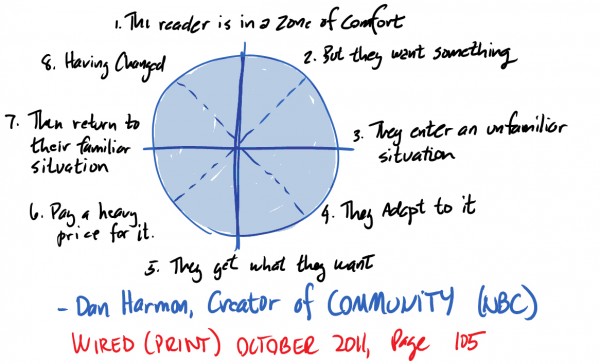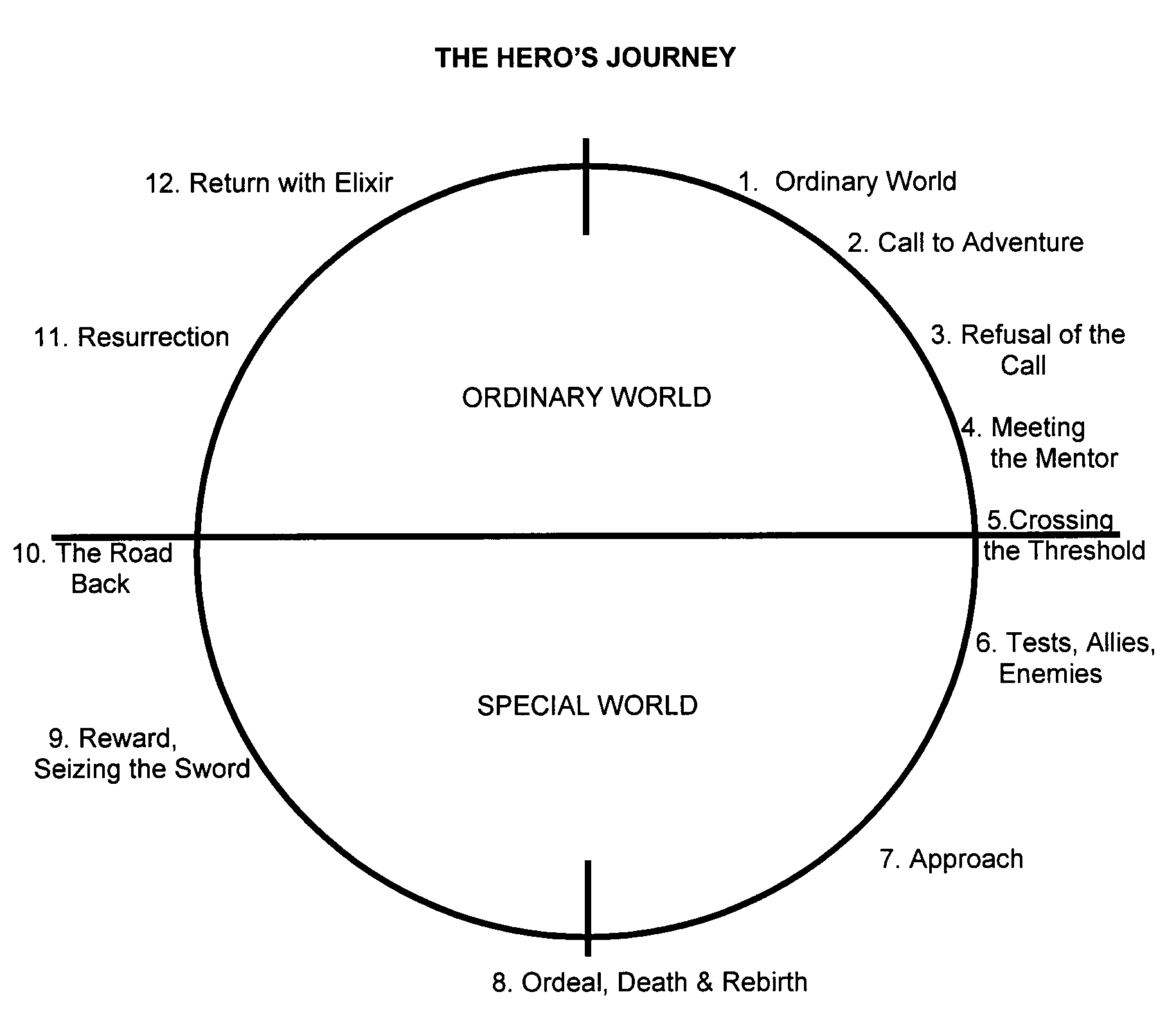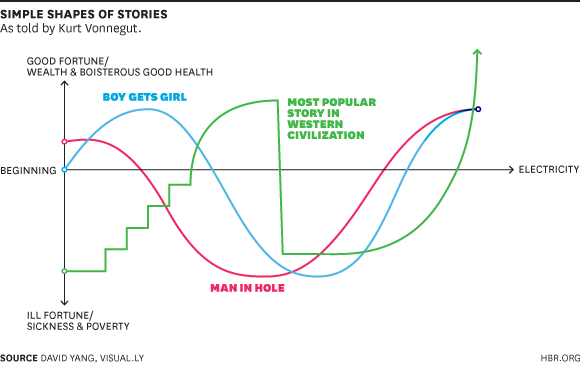Photo via PxHere
Stories have shapes. Any story you tell works best if you recognise its shape, then strengthen that shape. This applies to a story of any length, whether you’re putting in your 50,000 words for National Novel Writing Month 2017, or honing your favourite party anecdote, or even marketing something, including yourself. It even applies to Hemingway’s famous six-word story, “For sale: baby shoes, never worn.”
The three structural guides that follow aren’t the only templates for good writing. They just describe the vast majority of stories in literature, theatre, and film and TV up to this point. When you’re laying out your story, consulting these early on might save you some heavy rewrites down the road.
Dan Harmon’s Story Circle
Years before Community and Rick & Morty made him one of TV’s most famous showrunners, Dan Harmon made a web series called Laser Fart. It was the story of a superhero who could fart lasers. And it had surprising resonance, thanks to its strong structure.
In a series of essays on a wiki for web series creators, Harmon spelled out this structure, calling it the “story circle.” Read Harmon’s original essays on the Channel 101 Wiki, and see more discussion compiled here.
Harmon identifies eight stages to a story:
- A character is in a zone of comfort,
- But they want something.
- They enter an unfamiliar situation,
- Adapt to it,
- Get what they wanted,
- Pay a heavy price for it,
- Then return to their familiar situation,
- Having changed.
Writer Alex Crumb maps out the circle:

In general, use this guide to make sure your story is driven by your character’s actions. Note how this structure fuses a story’s obstacles to the protagonist’s goals. The character does something, so the world does something back, so the character does something back, and so on, like a game of tennis. Think of every Shakespeare play, and how all the obstacles come out of the hero’s and villain’s actions, and affect their next actions.
Or think of a typical sitcom episode, which starts with an obstacle disrupting the character’s comfort zone, and follows the character returning things to normal. (One of Harmon’s essays deals with adapting the story circle for TV.)
Your story doesn’t need to include all eight stages on the page, but remember that the readers will imagine the missing steps in their head. Hemingway’s micro-story starts at stage 8, as the would-be parent deals with the fallout of their tragedy. The famous short story “The Lady, or the Tiger?” ends on a cliffhanger. Both stories engage the reader by asking them to fill in the missing stages.
In many stories, each main character has their own story circle. On Community, Harmon and his staff would map out circles for each character, and often map whole circles for specific scenes.
In some stories, different character circles play out in different orders. In a mystery, the detective-protagonist usually follows a normal circle, while uncovering a second circle: the perpetrator’s. This second circle usually starts at the ending before working its way backward, as the detective figures out the methods and motives of the perp.
Read more about story circles in Wired’s profile of Harmon, and at the links compiled here.
Joseph Campbell’s Hero’s Journey
Harmon’s story circle is inspired by Joseph Campbell’s more complicated structure, the Hero’s Journey, as laid out in his book The Hero with a Thousand Faces. Campbell was primarily an academic, not a fiction writer, and his structure is more descriptive. It also includes more “optional” story elements.

Image via The Writer’s Journey
As an academic classification of all storytelling, Campbell’s analysis is controversial. But as a guide to mythic storytelling, it’s a buffet table of tropes. If you’re building an epic genre tale, you can follow Campbell’s circle rather literally. Stories like Star Wars and Lord of the Rings build new myths out of the tropes of old myths. (Lucas even cited Campbell as an influence.) It’s easy to grasp bizarre concepts like laser swords and slug-monster crime lords when they follow familiar storylines, storylines that predate the written word.
But with any kind of story, no matter how post-modern or mundane, you can add some heft and adventure by incorporating stages like the “refusal of the call” or “last-minute danger.” If you’re working on a comedy, you can ironically insert one of these stages, parodying our human need to package everything into predictable narratives.
Kurt Vonnegut’s Story Shapes
This isn’t physics, and there’s more than one way to think of your story structure. In his rejected master’s thesis in anthropology, Kurt Vonnegut charted out the structures of stories based on the characters’ good or bad fortunes:

Image by David Yang/HBR
This is a fascinating way to define genre, by emotional journey rather than by the trappings of setting. Vonnegut explains the chart above in an engaging five-minute talk:
Designer Maya Eilam graphs out more of Vonnegut’s story shapes, adding classic and modern examples. Note that Vonnegut’s shapes also apply to ancient myths. Their flexibility might offer you more insight than Campbell’s monomyth. If you’re struggling to fit your beats into a story circle, and you’re pretty sure the problem isn’t the beats, instead think about the story’s Vonnegut shape. Are you beating up your characters enough? Are you giving them enough of a resolution? If your graph goes flat or ends in the middle of the scale, is there a good reason?
Don’t let any of these shape guides pull your story in a way you don’t actually want it to go. If something is strongly pulling you in the “wrong” direction, then that’s just the right direction in disguise. Again, comedies often violate the norms of structure for a good reason, as do post-modern stories that challenge our typical narratives. But the best way to challenge a narrative is to understand it.

Comments